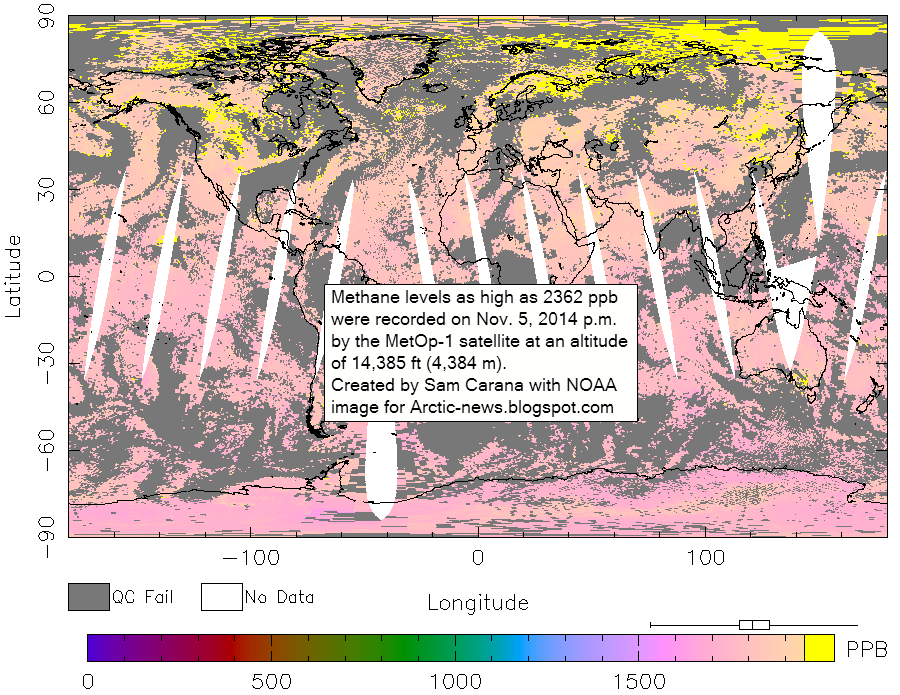Methane is erupting in huge amounts from the seafloor of the Arctic Ocean, as illustrated by the images below, showing methane over the East Siberian Arctic Shelf on October 31, 2014. The top image on the right shows methane at an altitude of 19,820 feet (6,041 m), on October 31, 2014, pm, as captured by the MetOp1 satellite.
The top image on the right shows methane at an altitude of 19,820 feet (6,041 m), on October 31, 2014, pm, as captured by the MetOp1 satellite. The middle image shows the location of the seas north of Siberia, and shows methane over the Arctic Ocean close to sea level, for reference.
The middle image shows the location of the seas north of Siberia, and shows methane over the Arctic Ocean close to sea level, for reference. The bottom image is an animation, starting at an altitude close to sea level and rising over 25 frames to an altitude of 19,820 feet (6,041 m).
The bottom image is an animation, starting at an altitude close to sea level and rising over 25 frames to an altitude of 19,820 feet (6,041 m).
As altitude increases, the methane can be seen emerging from the Laptev Sea at first, then spreading over further parts of the Arctic Ocean.
The yellow color indicates that methane is present at levels of 1950 ppb or higher.
High CO2 levels over Arctic Ocean
As in the previous post, an image has been added (below) showing recent carbon dioxide levels. Close to ground level (or rather sea level), mean CO2 level increased to 402 ppm on November 1, 2014 am, as measured by the MetOp-1 satellite.
The image below shows a comparison between CO2 (left) and methane (right).
 |
| [ Image added later, Ed. Click on image to enlarge ] |
Large methane eruptions from the seafloor of Arctic Ocean continue
The two images below [added later, ed.] further confirm the huge size of the methane erupting from the seafloor of the Arctic Ocean. The image directly below shows that levels as high as 2362 ppb were recorded on November 5, 2014 p.m.by the MetOp-1 satellite at an altitude of 14,385 ft (4,384 m) altitude. The image also shows that the methane is predominantly visible over the Arctic Ocean, further confirming that this is indeed the cause of the continued high methane levels.
The recent methane eruptions from the seafloor of the Arctic Ocean also appear to be pushing up methane levels at Mauna Loa, Hawaii, as measured by NOAA on November 6, 2014, as illustrated by the combination image below showing daily averages (left) and hourly averages (right).
Methane eruptions from Arctic Ocean seafloor look set to continue for months to come
As oceans keep warming, the Gulf Stream
will keep moving ocean heat into the Arctic Ocean, and ever more methane threatens to erupt from the seafloor of the Arctic Ocean.
The image on the right shows the huge sea surface temperature anomalies off the coast of North America and in the Arctic. Heat in the North Atlantic will take some time to travel to the Arctic Ocean, so this heat has yet to arrive there and contribute to cause further methane eruptions.
Nations are ignoring the growing dangers and keep each seeking a bigger share of a ‘carbon budget’, but in reality there is no carbon budget to divide. Instead, there is a huge debt built up by a joint failure of nations to act on pollution.
Increased methane eruptions from the seafloor of the Arctic Ocean threaten to further accelerate warming in the Arctic, in turn resulting in ever more methane being released, as illustrated in the image below, from an earlier post.
 |
The image below shows that global methane levels have risen from 723 ppb in 1755 to 1839 ppb in 2014, a rise of more than 254%. Growth did flatten down for a few years in the early 2000s, but the overall rise does not appear to slow down.
The right-end of this graph is shown in greater detail on the image below, which also has a trendline extended to the year 2021, against a background of methane levels measured by the MetOp-1 satellite on November 2, 2014, p.m.
Note that the image used as background in the plot area has different axis labels, i.e. latitude for the vertical axis and longitude for the horizontal axis. The image below gives the levels associated with the colors on the background image, with yellow indicating levels of 1950 parts per billion (ppb) and higher.
Remember that the level of 723 ppb in 1755 was not a paleo-historic low, but instead was the high peak of a Milankovitch Cycle. The image below further illustrates this point.
And so does the image below, by Reg Morrison.
Comprehensive and effective action needed
The situation is dire and calls for comprehensive and effective action. The Climate Plan seeks emission cuts, removal of pollution from soils, oceans and atmosphere, and further action, as illustrated by the image below, from an earlier post.










No comments:
Post a Comment